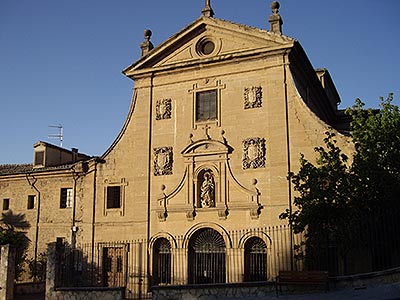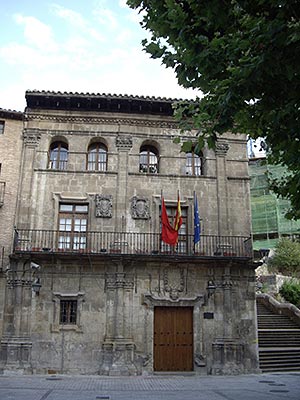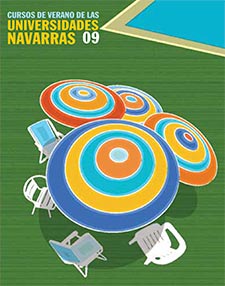BRINGING THE HERITAGE CLOSER. ESTELLA, ART AND THE ROAD
27 August 2009
Traces of the Baroque in Estella
Ms. Pilar Andueza Unanua. Chair of Navarrese Heritage and Art.
On the medieval essence of Estella, centuries later, the Baroque settled strongly, leaving visible traces. The seventeenth and eighteenth centuries were decisive for the capital of the Ega, as a good part of its convent architecture and the artistic decoration of its churches and parishes, as well as some of the most important civil buildings, such as the town hall or some outstanding stately homes, corresponded to the aforementioned artistic style. Throughout that period, therefore, a renovation of the old medieval city took place, which was endowed with a baroque imprint, adding to the medieval one it already had. The medieval monumentalization was thus joined by baroque monumentalization and, consequently, urban beautification.

Parish Church of San Juan de Estella. Altarpiece of St. Thomas
Several factors favored the development of the Baroque. Among them we can mention the progressive demographic increase of that time that brought with it new needs of the population, both in terms of domestic, institutional and religious architecture. Also of great importance was the apogee and economic strength of the city, thanks to its strategic geographic status , which allowed it to lead an important interregional trade and become one of the main centers of wool contracting in Navarre, which led to the presence of merchants and businessmen, without forgetting the importance of the guilds. Nor should we lose sight of the role played by Estella as a powerful artistic focus during the centuries of the Baroque, especially in the field of altarpieces and, finally, it is necessary to highlight the impact of the ideas emanating from the Council of Trent. In fact, Baroque art and its plastic means became, in the face of a largely illiterate society, one of the means used by the Church to move the devotion of the faithful and awaken their piety which, together with the magnificence of the temples and the solemnity of the celebrations, led to the proliferation of altarpieces (such as those of the convent of Santa Clara, the largest of the parish of San Miguel or the collateral ones of San Juan), pieces of silverware, liturgical ornaments, etc. In addition, the diffusion of that spirit was possible thanks to the intense foundational policy of the religious orders. In this sense, in Estella it is worth mentioning the foundation of the convent of the Conceptionist Recollects, as well as the total renovation of the monasteries of Santa Clara and San Benito, which were rebuilt under a baroque aspect. But to these conventual works were added numerous reforms in the parishes and, again following the post-conciliar devotions, the enlargement or renovation of the basilicas of Our Lady of Le Puy or that of Rocamador, without forgetting the enrichment of the chapel of the patron saint, St. Andrew.
In the field of urban planning, the city did not change its layout. However, it renovated its old medieval hamlet following the guidelines of the Zone average of Navarre.

Convent of the Conceptionist Recollects of Estella
Within the urban fabric there are three areas where the most outstanding baroque houses are concentrated. In the area of place de San Martín and Calle de la Rúa, the eighteenth-century Town Hall -today the Courthouse- stands out, with an important gallery of portraits of Spanish monarchs, and the house of the Chavarri family, popularly known as the Governor's Palace, which was built between 1609 and 1613. The various trades carried out by its promoter, Juan de Chavarri y Larráin, in the service of the monarchy led him to live in Valladolid and Madrid, which explains the building's close relationship with the Madrid architecture of the Habsburgs. A second area of concentration of important buildings, in spite of the architectural transformations carried out, can be found at place de los Fueros, where two magnificent stately examples stand out. This public space always acted as if it were a major place where not only the market was held but also various shows such as the bullfighting festival. Finally, the Calle Mayor offers magnificent buildings such as the Ruiz de Alda house, with its imperial staircase, the Modet house, which uses French-style grilles, or the Munárriz house, one of the most interesting buildings of the Navarrese Baroque style.

Old Town Hall of Estella

Estella. place de los Fueros. House
PROGRAM
TUESDAY, AUGUST 25
The splendor of Estella in the Renaissance. Art and Artists
Ms. María Concepción García Gainza. Chair of Navarrese Heritage and Art.
Image of God, image of man: the façade of San Miguel de Estella
Mr. Javier Martínez de Aguirre Aldaz. Complutense University of Madrid
San Pedro de la Rúa: styles and interstyles in a medieval building.
D. Carlos J. Martínez Álava. I.E.S. "Pedro de Ursua" of Pamplona
WEDNESDAY, AUGUST 26TH
Following in the footsteps of the Gothic in Estella: Santo Sepulcro and Santo Domingo
Ms. Santiaga Hidalgo Sánchez. Chair of Navarrese Heritage and Art.
Estella's movable heritage
Ms. Mercedes Jover Hernando. Chair of Navarrese Heritage and Art.
A city born for the Camino. visit guided tour of the city of Estella
D. Román Felones Morrás. Full Professor of Geography and History of the I.E.S. Tierra Estella.
THURSDAY, AUGUST 27TH
Architecture and Humanism in Estella in the 16th century.
Mrs. María Josefa Tarifa Castilla. Chair of Navarrese Heritage and Art.
Traces of the Baroque in Estella
Ms. Pilar Andueza Unanua. Chair of Navarrese Art and Heritage.
The sumptuary arts in Estella: from the Age average to the 19th century.
D. Ignacio Miguéliz Valcarlos. Chair of Navarrese Heritage and Art.
FRIDAY, AUGUST 28TH
Images of a conflict. Estella and the last Carlist War
D. Ignacio Jesús Urricelqui Pacho. Chair of Navarrese Heritage and Art.
reportIdentity and image of Estella in the plastic arts of the 19th and 20th centuries.
Mr. José Javier Azanza López. Chair of Navarrese Heritage and Art.
Museum and city. Gustavo de Maeztu and Estella
D. Gregorio Díaz Ereño. Director of the Jorge Oteiza Museum.
Closing

